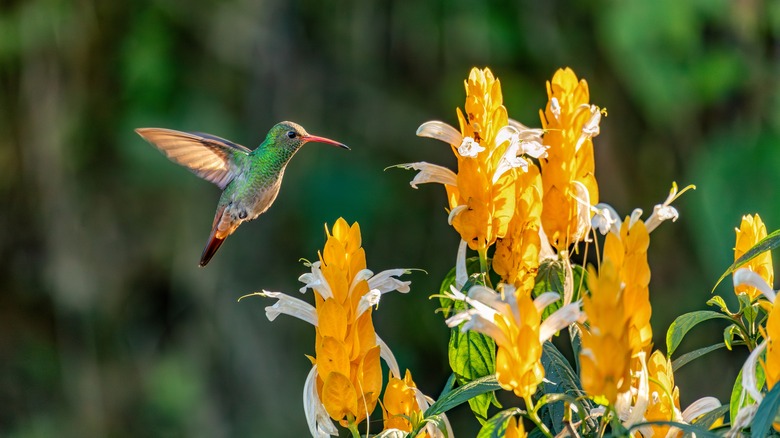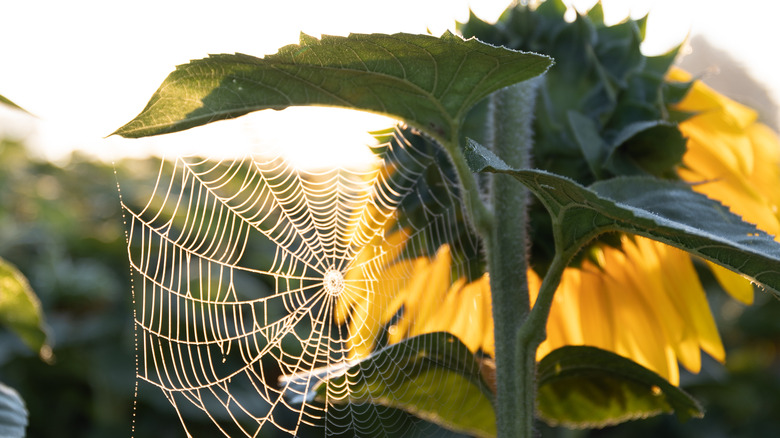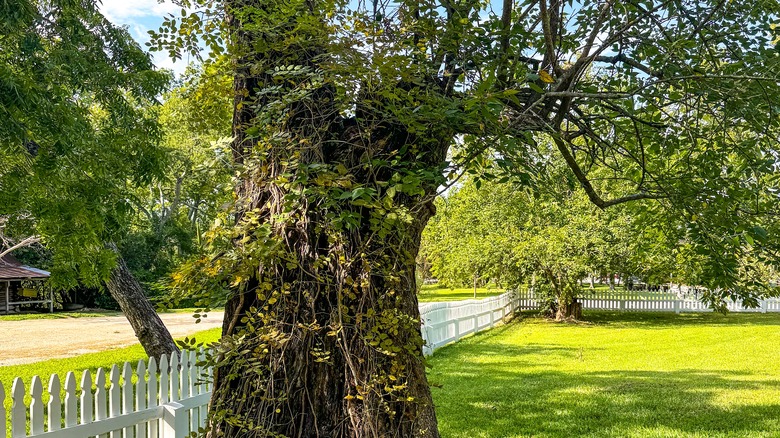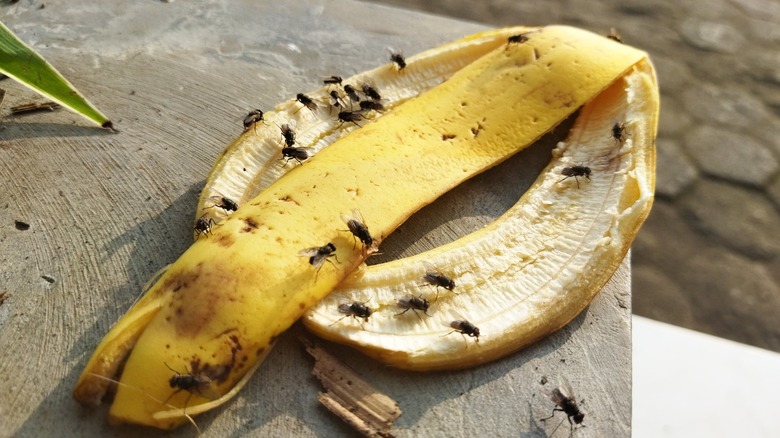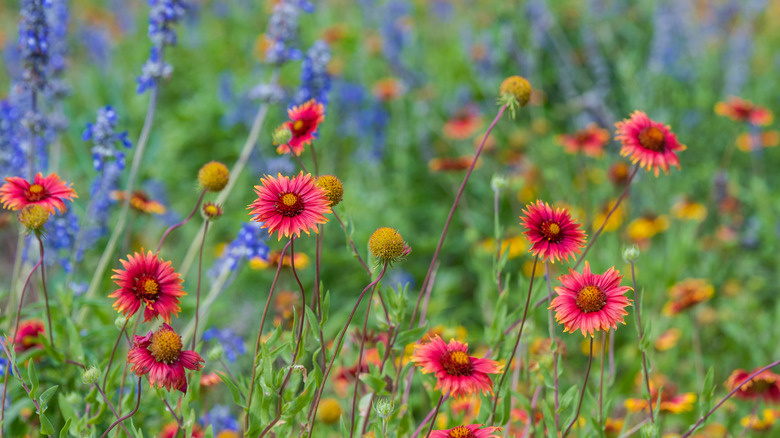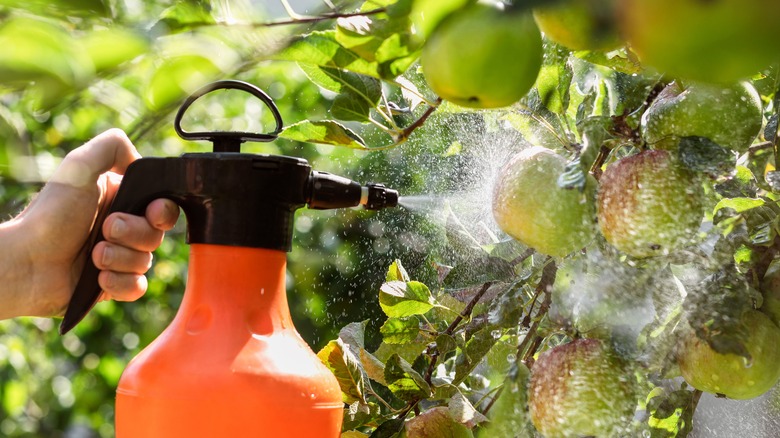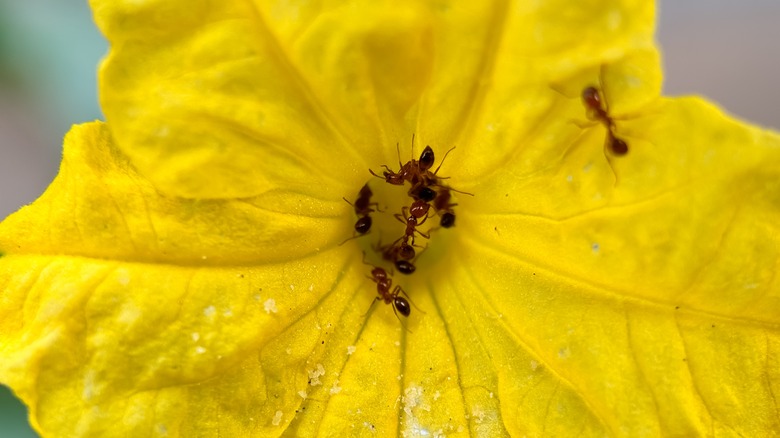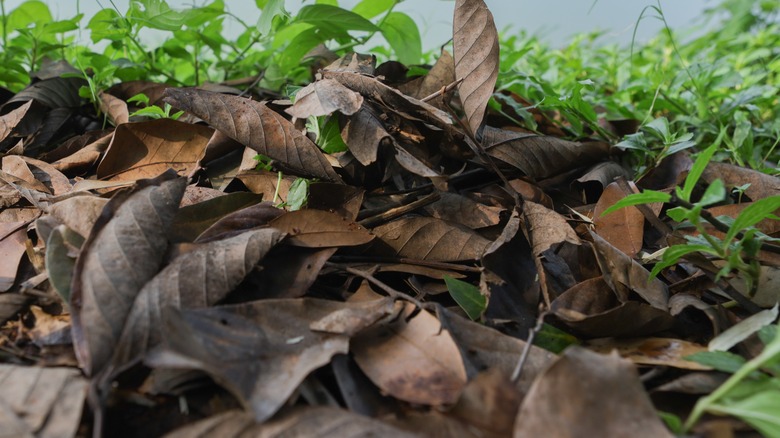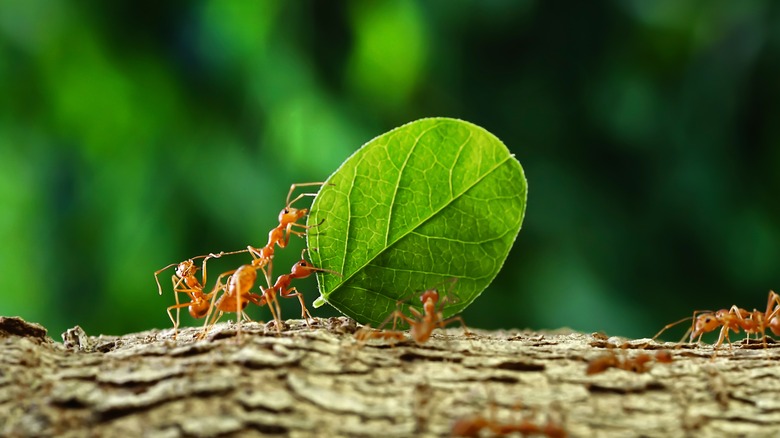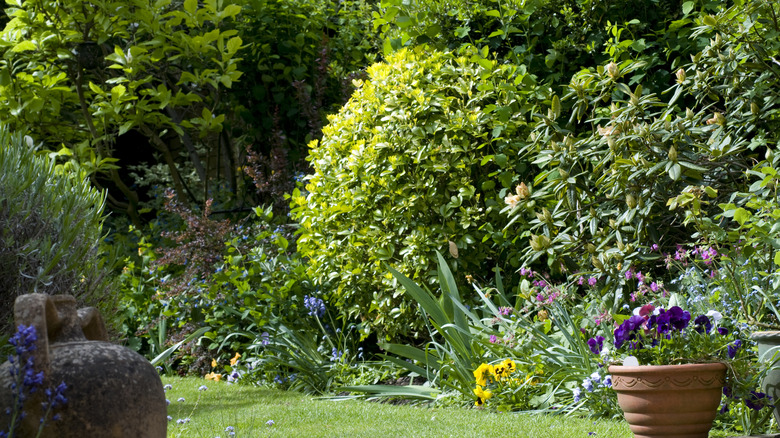Turn Your Yard Into A Hummingbird Feeding Ground With These Tips For Attracting Insects
We may receive a commission on purchases made from links.
Adding a wide range of nectar-rich plants can attract hummingbirds to the garden, but this isn't the only way to get their attention. Entomologist Doug Tallamy told the University of California that "hummingbirds like and need nectar but 80 percent of their diet is insects and spiders." Their insect and spider intake provides protein, which is essential for muscle and feather development, so creating an environment that will support a varied and balanced diet is sure to tempt hummingbirds into making repeat visits to your yard.
A hovering hummingbird will flap its wings around 90 times in a single second, which can burn some serious energy. They need to eat almost constantly to sustain this level of movement, consuming the equivalent of their body weight each day. Every 24 hours, a hummingbird can eat up to 1,000 bugs and visit as many as 2,000 flowers to get its fill of calories. Evidently, feeding ranks pretty high up on a hummingbird's to-do list, so by encouraging insects to inhabit your garden, you will effectively be encouraging hummingbirds to visit for a feast. This means that to attract more hummingbirds to the yard, you should increase both the diversity and population of insects in your garden, which can be achieved in various ways. Possibilities include planting more trees, which are a haven for a variety of bugs, and avoiding the use of pesticides that destroy insects in the garden. Here is a closer look at how to attract more insects to your yard.
Add lofty plants and structures to your yard as anchors for spiderwebs
Hummingbirds are known for feeding on tiny insects like flies and ants, but small arachnids are actually among their favorite foods. Many of us spend time trying to find ways to keep spiders out of our homes and gardens, but increasing the spider population of your yard could have numerous benefits. Along with keeping pest problems at bay, making your garden more spider-friendly can work as a lure for hummingbirds to get their next meal. You can attract small spiders by providing them with opportunities to build their webs. Weaving spiders like tall structures to create webs on, so adding these to your garden will make them want to set up camp.
To give spiders somewhere to secure themselves, create some height in your garden using tall plants, like sunflowers, cornstalks, and tomato plants. You could also consider positioning tall structures in the garden where spiders can build their webs, such as trellis and arbors. Scared of spiders? Not a problem. Keep the eight-legged creatures far from your home by fixing your tall structures and plants at the end of the yard. Here, they can be enjoyed by hummingbirds at a comfortable distance from you.
Grow trees to attract insects like caterpillars
Hummingbirds love to feast on small caterpillars, so inviting these creepy crawlies to the yard should mean you have more feathered visitors. One of the best ways to increase your caterpillar population is to plant trees known as top spots for caterpillars to hang out. Oak, willow, and birch trees are typically home to more than 300 different species of caterpillars, so these are great choices for the garden, as long as you have an appropriate space and a suitable climate. All trees provide shelter and nesting opportunities for a wide range of insects throughout the year, which will in turn be a draw for hummingbirds.
There are many types of oak trees you can plant in your yard, such as sand live oaks (Quercus geminata) which are very resistant to wind, and southern live oaks (Quercus virginiana) which can grow to whopping heights of up to 80 feet. Once established, oaks are easy to care for, but they generally work best in larger spaces. To attract caterpillars as a food source for hummingbirds in smaller yards, try compact varieties of birch trees, such as the 'Trinity College' Himalayan birch (Betula utilis jacquemontii 'Trinity College') which has an ultimate size of around 16 feet by 10 feet. You can also consider planting alternative, smaller species that attract caterpillars, such as crabapples, maples, or pines.
Utilize fruit peelings to bring more flies to the garden
Masses of fruit flies buzzing around your fruit bowl are enough to make anyone's stomach turn, but this is exactly the sort of sight that will make a hummingbird's mouth water. One hummingbird will eat several hundred flies in a single day, so an abundance of these pesky pests will be needed to keep the birds coming back for more. A great tip anybody can use is luring fruit flies to the garden with old fruit. If you have peaches, plums, pears, apples, or any other sweet fruit that is past its best, you can hang it up in the garden and quickly have a swarm of flies that hummingbirds will gobble up for dinner. No fruit going bad? No problem. Use banana peels instead to catch the attention of all the local flies.
To keep fruit flies out of your kitchen and in the garden instead, be sure to hang your bad fruit far from the house. Positioning the fruit close to a hummingbird feeder will help to guarantee the birds spot their tasty prey. You could set your fruit in a hanging basket and attach it to a tree branch or hook it onto the top of a fence. However, you may want to skip this hack if you have a raccoon or cockroach problem, as this will only attract them more to your yard.
Native plants make for a more diverse insect ecosystem in your yard
Native plants encourage more diversity in local insect populations, which are an important food source for many birds, including hummingbirds. You can help sustain and increase the amount of insects in your yard simply by planting predominantly native species. This is an argument that has been pushed by Douglas Tallamy from the Department of Entomology and Wildlife Ecology at the University of Delaware for many years. In a 2018 study called "Nonnative plants reduce population growth of an insectivorous bird," he explained, "the widespread preference for nonnative plants in the horticultural industry has globally transformed millions of acres from potential habitat into 'food deserts' for native insects, with the unintentional consequence of reducing the abundance and distribution of birds as well."
Planting native plant species offers numerous benefits to the garden and the gardener because these plants are more likely to thrive in the local environment and require minimal care. They will support a greater variety of bugs compared with nonnative, ornamental plants, therefore broadening the menu for hummingbirds. You can find out which plants are native to your local region by searching online, or by browsing a book detailing the best native plants for different areas, such as 'Native Plants of the Northeast: A Guide for Gardening and Conservation', which is a book available on Amazon.
Pass on pesticides to maximize insect populations
To increase the number of insects in your garden, and ultimately attract more hummingbirds, you'll need to resist using pesticides. While pesticides can represent an easy solution for keeping those annoying critters off your homegrown veggies, they are also one of the key barriers to creating a thriving ecosystem of insects and spiders. When a garden is routinely treated with synthetic pesticides, the population of creepy crawlies will dwindle, and as a result, fewer birds will visit the yard. Young hummingbirds still in the nest survive almost entirely on spiders, so a garden where arthropods have been eliminated is no place for these birds to set up a home. Pesticide usage can also be harmful to the likes of hummingbirds, who could accidentally ingest the chemicals when they are feeding on the nectar of treated flowers.
Eliminating the use of pesticides in your garden is a simple way to help ensure insect communities thrive, creating more feeding opportunities for hummingbirds. If you are struggling with pest infestations on particular plants, treat these individually rather than applying pesticides across the whole garden. Take care to avoid spraying chemicals near bird feeders. You could also try to naturally repel pests from your garden to prevent unintentionally harming visiting birds. For example, companion planting is one way to minimize pest problems while retaining a thriving society of beneficial insects.
Grow plants that insects love
Cultivating plants that hummingbirds pollinate is a great way to attract these feathered friends to the yard, but don't forget to also include insect-pollinated plants. Flowers that are known to attract ants and other small critters will keep hummingbirds returning to the garden for their next snack, so these are a vital part of any bird-friendly landscaping. They will help ensure the birds get a well-rounded diet of both insects and nectar. Flowers that are popular with insects include milkweeds, yarrows, and peonies, so grow these in your garden and witness the hummingbirds come flocking for a feast of tasty bugs.
Yarrow (Achillea millefolium) is an easy plant to grow that blooms all summer long, attracting ants to the flowers, which in turn, will garner the attention of local hummingbirds. Plant it in well-draining soil and in a spot that experiences full sun to achieve the greatest abundance of blossoms. Milkweed (Asclepias syriaca) is another summer bloomer. It is a wildflower that can be aggressive and weed-like, but it offers a delightful fragrance and is a magnet for pollinators. They can easily spread across your garden via rhizomes underground, so to keep them contained, plant them in barriers like large planters. To keep hummingbirds happy in fall, plant sedum. These plants bloom from the end of summer and into fall, and will usually have flowers that are shrouded in insects because there is little competition from other plants at this time of year.
Keep garden clean-up minimal to create overwintering spots for insects
If you want to keep insect habitats intact, think twice before you clean up your garden at the end of summer. Tidying up garden debris and trimming back shrubs might make the yard look neater, but it disturbs inhabiting insects. As pollen is in short supply through fall and winter, it's especially important that hummingbirds can get their beaks on insects as sustenance throughout these months. To avoid limiting a hummingbird's access to insects, you can resist the urge to clean up your garden as it heads into fall.
Fall clean-up isn't just for making your garden look pretty, it's also a key way to minimize the likelihood of pests taking up residence in your yard. Unfortunately, the kind of spaces that insects like to take shelter in are also the kinds of spaces that will attract troublesome pests like rats and snakes. Because of this, you might want to skip this tip if your neighborhood has an issue with them. If it doesn't, but you would rather not attract them to your yard accidentally, then you can strike a balance by cleaning up most of the area to reduce hiding spots while leaving some parts undisturbed for insects. Allowing just a few sites for insects to inhabit should keep snakes from slithering into your yard and encourage rats to look for more convenient shelter.
Change your perception of ants being a problem and welcome them to the yard
Anyone who has ever suffered from an ant infestation in their home may shudder at the prospect of inviting these insects into the garden. Ants in the house are an infuriating problem that can be difficult to resolve, and many of us will have spent hours trying to find the best ways to get rid of ants once and for all. However, ants in the yard are a different story entirely. They form an essential part of the ecosystem and are known to be a popular snack for hummingbirds.
Hummingbirds love to forage, so leaving ant populations intact means you might witness them using their long beaks to snatch ants from leaves or blades of grass. Ants are among a hummingbird's favorite foods, and they provide an important source of protein that supports the proper growth and development of muscle and feathers. Keep the ant baits for inside the home, and let your outdoor ants roam free.
Favor shrubs and trees over a lawn
A well-maintained lawn can be very visually appealing, but they aren't the best use of space in the garden if you want to attract insects for hummingbirds to feed on. The diversity of insects found in grassy, well-kept lawns is disappointing, and plastic lawns are even worse. To encourage insects and birds into your yard, put a focus on cultivating shrubs and trees instead. These plants harbor a rich variety of spiders and insects so hummingbirds get a more balanced diet.
If you have a large garden with enough space to accommodate both a lawn and multiple native shrubs and trees, then you will likely be able to attract hummingbirds and other birds quite easily. Some great picks are the silver birch, which attracts over 300 different bugs, and the whitebeam, a flowering tree. Plant them across the turf, creating a mini-forest in your backyard. However, people with small gardens may need to prioritize border plantings. For example, eat up a portion of your lawn to plant thick rows of hedges like hawthorn, beech, and hazel attract caterpillars, which hummingbirds can snap up. Even a patio or terrace garden can become a haven for insects if you design and landscape in a way that makes the most out of a small backyard.
